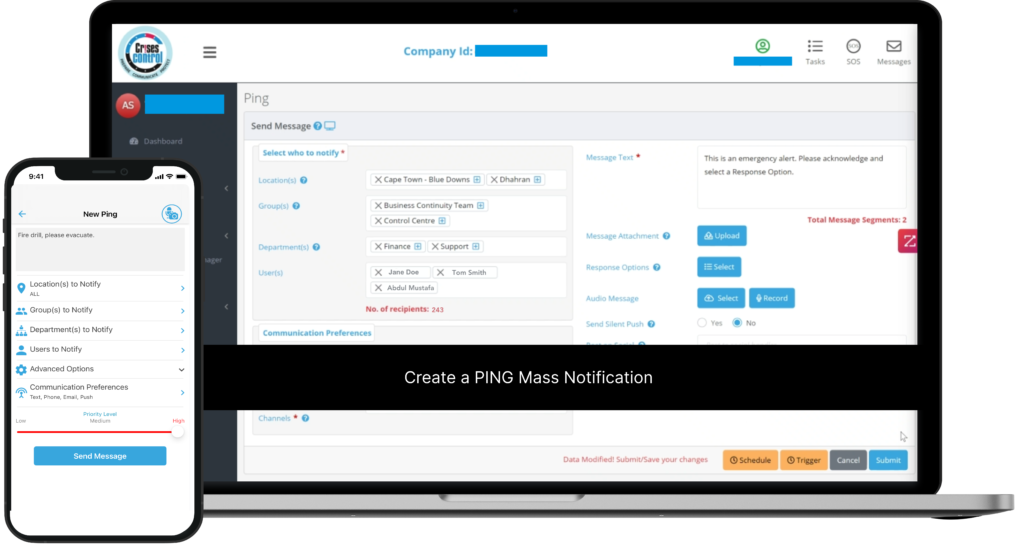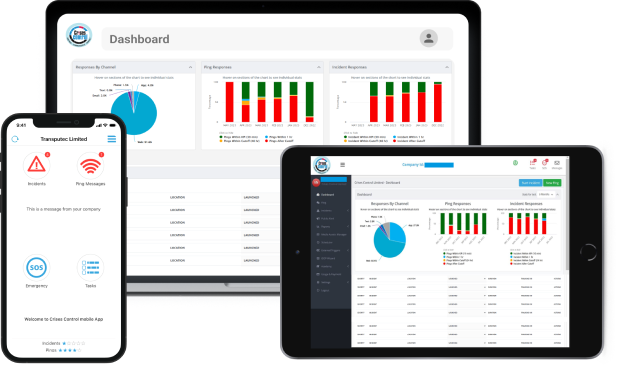Written by Anneri Fourie | Crises Control Executive
Introduction: When Minutes Matter in an Emergency
Imagine this: an insurance company’s IT system suddenly crashes in the middle of a busy working day. Claims cannot be processed, customer data access is lost, and internal communication slows to a crawl. The clock is ticking and the pressure is mounting. Staff are unsure what to do, and customers begin to feel the impact. This is not a hypothetical situation; it happens all too often.
Insurance firms are responsible for managing sensitive information and providing crucial services to their customers. When emergencies occur, whether a cyberattack, a fire alarm, or a critical IT outage, the way a company responds can prevent chaos or cause it. One of the biggest stumbling blocks firms face during these moments is slow or ineffective communication.
The solution lies in having a reliable emergency notification system that can alert the right people immediately, keep everyone informed, and coordinate a fast response. Without it, firms risk not only operational disruption but also damage to their reputation and compliance issues.
This blog explains the real challenges insurance companies face in emergency communication and how a modern system, such as the one offered by Crises Control, can make a tangible difference.
Why Insurance Firms Can’t Afford to Delay Emergency Alerts
Insurance companies operate in an environment where every minute counts. Whether it is a security breach, a building evacuation, or an IT outage, delays in alerting the workforce can quickly escalate problems.
For instance, a delayed warning about a fire alarm or a building lockdown not only endangers employee safety but can also lead to legal consequences if the firm fails to meet health and safety standards. Similarly, slow communication during IT system failures prolongs downtime, frustrates customers, and costs money.
Traditional communication methods like emails or phone trees are too slow and unreliable when quick action is needed. Often, alerts get lost or ignored, and messages become inconsistent.
In a business where trust and reliability are key, this is unacceptable. What is needed is a system that can send instant alerts through multiple channels to every employee, regardless of location, with clear instructions on what to do next.
Common Communication Problems Facing Insurance Firms During Emergencies
Before we explore solutions, it helps to understand the common issues that insurance firms encounter:
1. Slow and Fragmented Alerts Cause Confusion
Many insurance firms rely on a mix of communication tools such as emails, phone calls, and informal chat groups. This patchwork makes it difficult to deliver urgent messages fast and clearly. Staff may receive notifications at different times or from different sources, leading to confusion and delays.
2. Outdated Business Continuity Plans Are Hard to Use
It is common for firms to have business continuity plans locked away in PDFs or spreadsheets. When an incident happens, staff have to manually locate, interpret, and put these plans into action, a process that wastes precious time and risks mistakes.
3. Lack of Real-Time Updates and Two-Way Communication
Emergencies are unpredictable and often evolve quickly. Without a system that allows managers to send updates and receive confirmations or questions from employees, it is nearly impossible to manage the situation effectively.
4. Difficulty Reaching Remote and Distributed Teams
Insurance companies increasingly have employees working from multiple offices or from home. Traditional alert methods often fail to reach remote workers promptly, especially if they rely on office phone systems or emails alone.
5. Pressure to Comply with Regulations and Provide Evidence
Insurance is a heavily regulated industry. Firms must prove they handled emergencies correctly and kept records of communications for audits. Without automated logging, producing this evidence is time-consuming and prone to error.
How Crises Control Makes Emergency Communication Work
Crises Control understands these challenges and offers a platform designed specifically to meet the needs of insurance companies.
Instant Alerts Through Multiple Channels
The platform sends notifications instantly via SMS, email, voice calls, Microsoft Teams and mobile app push messages. This means that every employee, whether in the office, working remotely, or on the move, receives alerts at the same time. This multi-channel approach avoids delays and ensures no one misses critical messages.
One-Click Activation of Business Continuity Plans
Rather than hunting through documents in a crisis, staff can launch digitised business continuity plans with a single click. These digital templates guide the response automatically, reducing confusion and speeding up action.
Real-Time Incident Management and Two-Way Communication
Crises Control’s incident management tool lets crisis teams update the situation as it unfolds and assign tasks directly through the platform. Employees can confirm receipt of messages, report status, and ask questions, allowing managers to adjust plans on the fly.
Designed for a Mobile and Decentralised Workforce
Recognising that insurance workforces are spread across locations and often working remotely, Crises Control’s platform is mobile-first. It works across all devices and networks, so alerts reach employees wherever they are, ensuring no one is left out.
Automated Compliance and Reporting
Every alert sent, task assigned, and response received is logged automatically. These records form a full audit trail, which is vital for meeting regulatory requirements and simplifying post-incident reviews.
Coordinated Safety Drills and Evacuations
Beyond actual emergencies, Crises Control helps firms organise safety drills and evacuations more effectively. It schedules alerts, tracks who has participated, and collects acknowledgments, so firms know their teams are prepared.
Interested in our Ping Emergency Notification System?
Efficiently alert everyone in seconds at scale with our Emergency Notification System – PING, get the message out fast and ensure rapid response and recovery.

The Real Benefits of a Reliable Emergency Notification System for Insurance Firms
Implementing a dependable notification system offers more than just speed. Here are some key benefits insurance firms can expect:
Minimise Downtime and Protect Customer Service
Quickly alerting IT teams and business units when systems fail means problems can be fixed faster. This reduces disruption to claims processing and customer service, protecting revenue and client satisfaction.
Keep Employees Safe and Confident
Timely alerts and clear instructions improve employee safety during physical emergencies. When workers feel confident that the company can handle crises well, it boosts morale and loyalty.
Streamline Crisis Response to Avoid Chaos
Digitised workflows and automated alerts reduce the risk of mistakes or missed steps. This helps managers make clear decisions quickly and keeps everyone on the same page.
Meet Regulatory Requirements with Ease
With detailed logs and automated reports, firms can demonstrate compliance with FCA, DORA, Solvency II, and other frameworks. This reduces risk of fines and builds trust with regulators.
Build Trust with Stakeholders
Showing that your firm has a robust emergency system in place builds confidence among clients, partners, and employees alike. It sends a clear message that safety and reliability are priorities.
Conclusion: Take Control of Your Emergency Communication
Emergencies will happen, it’s a question of when, not if. What matters most is how your firm responds. Slow or unclear communication leads to chaos, lost time, and risk to people and business.
A reliable emergency notification system gives you the tools to send fast alerts, coordinate your team, and meet regulatory demands with confidence.
Crises Control provides insurance firms with a powerful, easy-to-use platform that solves common pain points like delayed alerts, fragmented communications, and manual business continuity execution. It ensures that when the next crisis strikes, your response is swift, clear, and controlled.
If you want to see how Crises Control can help protect your firm and staff, contact us today for a free demo.
Request a FREE Demo

